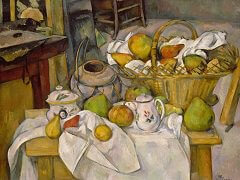Woods with Millstone, 1894 by Paul Cezanne

Cezanne painted the Woods with Millstone in the South near his home at Aix. A photograph of the spot proves him remarkably faithful to the encountered scene which offered him an example of a natural chaos with traces of man in the abandoned blocks of quarried stone. But what concern us are the qualities of the picture which arc more intense or of another order than those of the original site. The image is of an interior of nature, like a cavern, obstructed and without horizon or exit or outlook beyond, a wild romantic site with something of melancholy and hopelessness, but also the fascination of a huge disorder. It is the grotto of the raging, blinded Polyphemus, strewn with natural and human debris. Only the millstone with its smooth and centered form set oddly in a corner is a note of humanity at home, against which we may measure the turmoil of the other forms. Yet its purity or abstractness of shape makes it seem less human than the roughness of the rocks and trees.
The space as a hollow has no definite form; the tilted ground fuses with the objects that rise from it and with the masses of foliage in a vertical effect like the still lifes of the same time. Lines radiate in different directions from the same axis or cross each other in their opposed movements. It is a painting built of unstable forms, without vertical or horizontal lines, completely un-architectural in spirit. Yet it is a powerfully ordered canvas in which we discover as intense a search for harmony as in the most serene works. Very striking is the pairing of elements: twin trees, twin branches, twin rocks, twin blocks of cut stone, which are composed with an eye to contrast and delicate variation as well. Especially fine is the conception of the graceful trees, twisted and divergent at the left, more smoothly curved and parallel at the right. Within the chaos of the site survives something of a natural order and rhythm.
An interesting invention is the trail of the diagonal on the ground: a shadow line at the extreme right continued in the blocks of stone and resumed in a further shadow line carried to the other end of the canvas. In its slope and fine curvature, in its changing color and branching detail, this line is like the tree trunks and introduces in the ground an element that appears most strongly in the vertical planes.
The color is a somber harmony of brown, violet, green, and grey - mixed tones that belong to an enclosed, sunless world. But this scale is illuminated by a stormy flashing of lights and darks, which also create a powerful modeling. In the rocks are daring divisions of the surface modeled with abrupt contrasts of color. The whole is painted with a wonderful sureness, but also with a passion approaching fury. It is rendered as if by a giant for whom these objects are his most familiar world.














